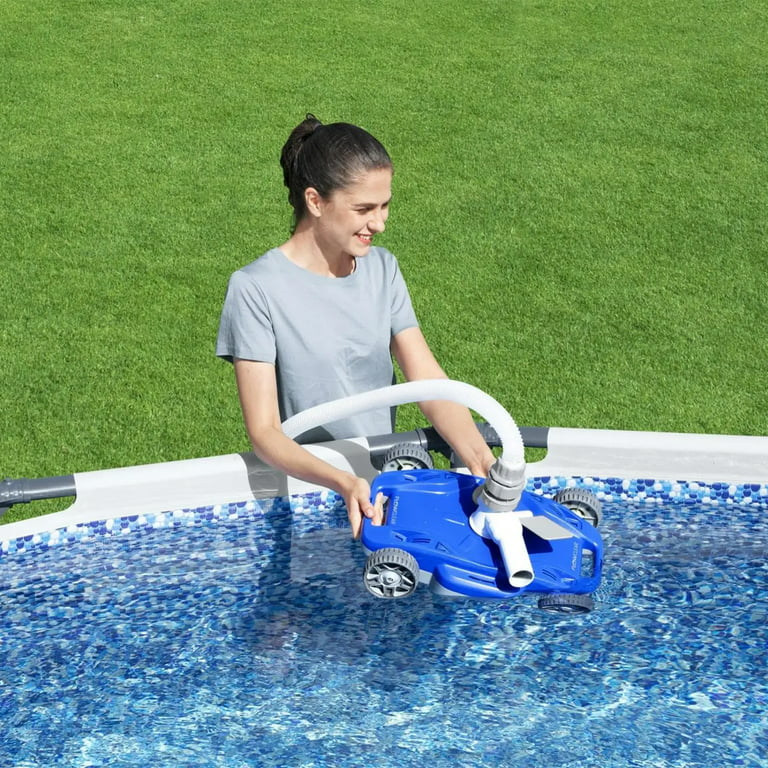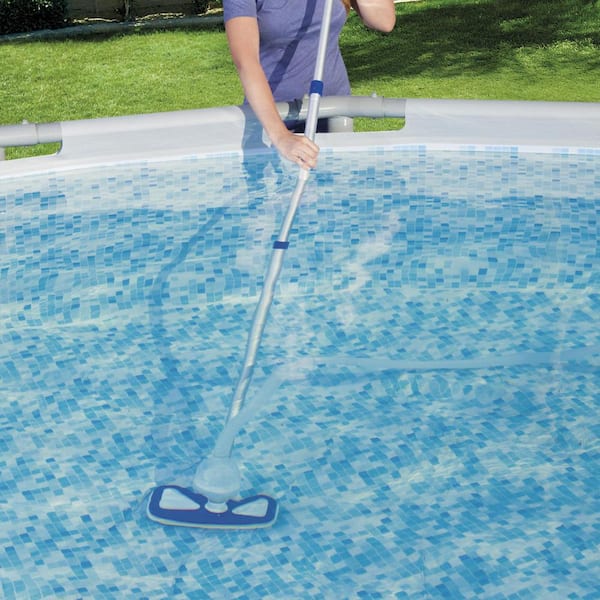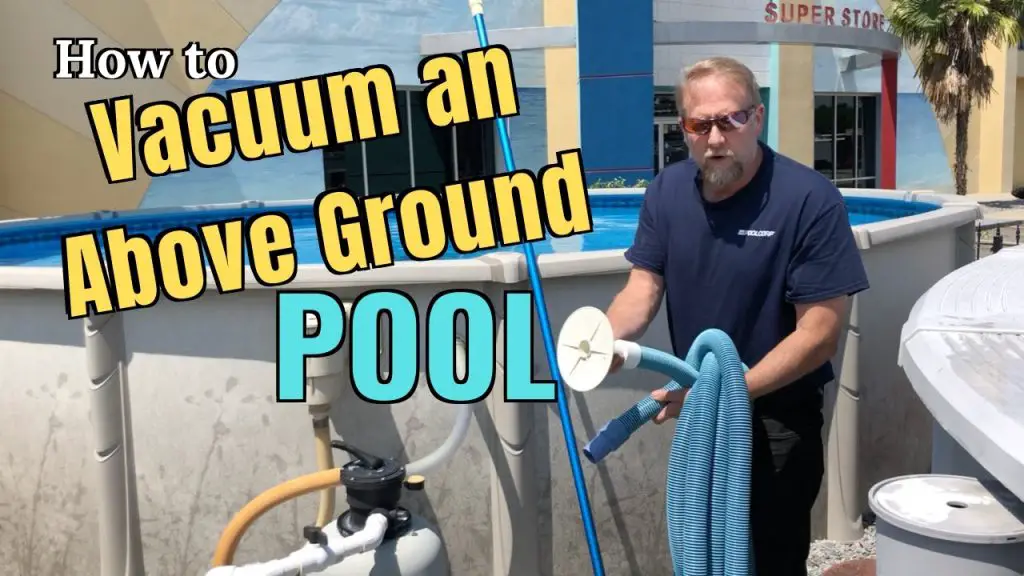To vacuum above ground pool, attach the vacuum head to the telescopic pole, connect the vacuum hose to the vacuum head, and lower the vacuum head into the pool. Move the vacuum head slowly back and forth, covering the entire pool surface, and empty the skimmer basket regularly to remove debris.
Are you a pool owner looking for an effective and hassle-free way to keep your above ground pool clean and pristine? Maintaining cleanliness in your pool is essential for a enjoyable swimming experience, and vacuuming is a crucial part of this process.
Whether you’re dealing with leaves, dirt, or other particles, knowing how to properly vacuum your above ground pool can make all the difference. We will guide you through the steps of vacuuming your above ground pool, ensuring that you have the necessary tools and techniques to achieve a sparkling clean pool. Keep reading to discover top tips and expert advice for effective pool vacuuming.

Credit: www.walmart.com
Preparation
Vacuuming an above ground pool is an essential part of pool maintenance to keep the water clean and clear. Proper preparation is key to ensuring you can efficiently and effectively vacuum your pool. In this blog post, we’ll cover the essential steps for preparing to vacuum your above ground pool, including gathering essential tools and checking the pool’s condition.
Gathering Essential Tools
Before starting the vacuuming process, it’s crucial to gather all the necessary tools and equipment. Having the right tools at hand will save time and ensure a successful cleaning session.
- Vacuum Head: The vacuum head is essential for physically removing debris from the pool floor.
- Telescopic Pole: This adjustable pole allows you to easily reach all areas of the pool while vacuuming.
- Hose and Vacuum Plate: These components are necessary for connecting the vacuum head to the pool’s filtration system.
- Skimmer or Leaf Rake: These tools are useful for removing larger debris from the pool’s surface before vacuuming.
- Water Testing Kit: It’s important to have a water testing kit on hand to check the pool’s chemical balance before and after vacuuming.
Checking Pool’s Condition
Prior to vacuuming, it’s essential to assess the condition of the pool to ensure a safe and effective cleaning process.
- Water Level: Ensure that the water level in the pool is within the recommended range to allow for efficient vacuuming.
- Chemical Balance: Test the pool water to ensure that the pH and chlorine levels are within the optimal range for vacuuming.
- Remove Large Debris: Use a skimmer or leaf rake to remove any visible large debris from the pool’s surface before vacuuming.
- Clean Filter: Check and clean the pool filter if necessary to ensure proper suction during the vacuuming process.
- Inspect Vacuum Components: Ensure that the vacuum head, hose, and other components are in good condition and properly connected before starting the cleaning process.

Credit: www.homedepot.com
Choosing The Right Vacuum
When it comes to maintaining the cleanliness of your above ground pool, choosing the right vacuum is essential. With a plethora of options available, it’s crucial to understand the types of pool vacuums and the factors to consider before making a decision.
Types Of Pool Vacuums
There are various types of pool vacuums available in the market, each designed to cater to specific cleaning needs. Understanding the differences between these types can help you make an informed choice.
- Manual Pool Vacuums: These require manual operation and are ideal for spot cleaning and smaller pools.
- Automatic Pool Vacuums: These are self-contained units that operate independently, providing thorough cleaning without manual intervention.
- Robotic Pool Vacuums: These advanced devices are equipped with intelligent programming and can navigate the pool efficiently, removing debris and dirt with minimal effort.
Factors To Consider
Before investing in a pool vacuum, consider the following factors to ensure you select the most suitable option for your above ground pool:
- Pool Size: Consider the size of your pool to determine the vacuum’s cleaning capacity and coverage area.
- Debris Type: Assess the type and amount of debris that typically accumulates in your pool to choose a vacuum capable of effectively handling it.
- Maneuverability: Ensure the vacuum is maneuverable enough to reach all areas of your above ground pool, including corners and steps.
- Filtration System: Opt for a vacuum with a reliable filtration system that can trap both fine particles and larger debris.
- Energy Efficiency: Select a vacuum that is energy-efficient to minimize operating costs and environmental impact.
Steps To Vacuuming
Vacuuming your above ground pool regularly is essential to maintain its cleanliness and hygiene. Keeping your pool free from debris not only ensures crystal clear water but also helps to prolong the life of your pool equipment. In this article, we will guide you through the simple steps to vacuuming your above ground pool effectively.
Setting Up The Equipment
Before you begin the vacuuming process, it’s important to set up the necessary equipment. Here is a step-by-step guide to help you:
- Step 1: Start by checking the water level in your pool. For optimal vacuuming, the water level should be at least halfway up the skimmer opening.
- Step 2: Next, gather your pool vacuum equipment, including the vacuum head, telescopic pole, and vacuum hose.
- Step 3: Attach the vacuum head to the telescopic pole securely.
- Step 4: Carefully attach one end of the vacuum hose to the vacuum head, ensuring it is tightly connected.
- Step 5: Now, slowly lower the assembled vacuum head and pole into the pool while holding onto the other end of the vacuum hose.
- Step 6: Submerge the vacuum head completely, allowing the hose to fill with water. This will help to create suction.
- Step 7: Once the hose is filled with water, attach the other end to the pool’s skimmer or designated suction port.
- Step 8: Ensure that the connections are secure and free from any leaks.
Starting The Vacuuming Process
Now that you have set up the equipment, it’s time to start the actual vacuuming process. Follow these steps to get started:
- Step 1: Turn on the pool pump to initiate the circulation.
- Step 2: With the pool pump running, slowly maneuver the vacuum head across the pool’s floor, starting from one end.
- Step 3: Keep the movements steady and methodical, overlapping each pass slightly to ensure thorough cleaning.
- Step 4: As you vacuum, pay extra attention to areas with visible debris, such as leaves or dirt particles.
- Step 5: Continue vacuuming until the entire pool floor and walls are clean and free from debris.
Navigating The Pool
During the vacuuming process, it is important to navigate your pool correctly to achieve the best results. Here are some tips to keep in mind:
- TIP: Start vacuuming from the furthest point away from the skimmer or suction port, gradually working your way back.
- TIP: While vacuuming, move slowly and purposefully to prevent stirring up debris and disturbing the water.
- TIP: If your pool has steps or ladders, pay extra attention to these areas as dirt and debris tend to accumulate there.
- TIP: Once you have vacuumed the entire pool, turn off the pool pump and disconnect the vacuum equipment carefully.
- TIP: Rinse off the vacuum head, telescopic pole, and vacuum hose thoroughly with clean water before storing them away.
Following these simple steps will help you maintain a clean and inviting above ground pool. Make sure to vacuum regularly to enjoy a refreshing swimming experience all summer long.

Credit: m.youtube.com
Tips For Efficient Cleaning
When it comes to maintaining your above ground pool, efficient cleaning is key. Below are some useful tips for ensuring your pool stays clean and inviting:
Cleaning Frequency
Regularly cleaning your above ground pool is essential for keeping it in top condition. Aim to vacuum the pool at least once a week to remove dirt and debris.
Inspecting Pool For Debris
Before starting the vacuuming process, carefully inspect the pool for any debris such as leaves or twigs that may clog the vacuum. Clearing these before vacuuming will make the process more effective.
Dealing With Specific Debris
When vacuuming an above-ground pool, handling specific debris requires a focused approach. Target leaves, twigs, and dirt meticulously for effective cleaning results. Enhance your pool maintenance routine by efficiently dealing with varying types of debris.
Leaves And Larger Debris
Algae Infestation
Maintaining Water Quality
Vacuuming your above-ground pool is essential for maintaining water quality. Keeping the water clean and free of debris ensures a safe and enjoyable swimming environment for your family and guests. In this section, we will discuss the important aspects of maintaining water quality, including balancing chemicals and filter maintenance.
Balancing Chemicals
Properly balanced chemicals are crucial for preserving the water quality in your above-ground pool. Here’s how you can maintain the right chemical balance:
- Regularly test the water for pH, chlorine, and alkalinity levels
- Add pool chemicals as per manufacturer’s instructions to adjust pH and alkalinity levels
- Keep chlorine levels within the recommended range to prevent algae and bacteria growth
Filter Maintenance
Regular maintenance of your pool’s filter is essential for efficient removal of dirt and debris. Follow these steps to ensure proper filter maintenance:
- Backwash the filter system according to the manufacturer’s instructions
- Check and clean the filter cartridge regularly to prevent clogging
- Replace the filter media as recommended by the manufacturer
Conclusion
For a sparkling clean above ground pool, follow these simple vacuuming tips and techniques. With regular maintenance, your pool will stay inviting and safe for everyone to enjoy. Keep up with routine cleanings to ensure your pool remains a source of refreshment and relaxation all season long.




